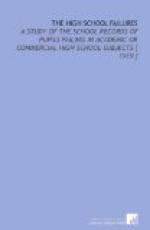[Footnote B: It is a significant fact, and one worthy of note here, that the report for St. Paul is apparently the only one of the surveys which also states the number taking each subject, as well as the percentages of failure. Percentages alone do not tell the whole story, and they do not promote the further utilization of the facts to discover other relationships.]
The facts presented for St. Louis[9] are for one school only, with 2,089 pupils, as recorded for the first half of the year 1915-16. All foreign languages as reported for this school are grouped together. History is the only subject that has a percentage of failure lower than that of the corresponding subjects for our eight schools. The figures for both St. Paul and St. Louis are based on the grades for all classes in school, but for only a single semester. One cannot avoid feeling that a statement of facts for so limited a period may or may not be dependable and representative for all periods. The percentages for Paterson[10] are reported for about 4,000 pupils, in all classes, for two successive semesters, and are based on the number examined. For Denver,[11] the records are reported for 4,120 pupils, and cover a two-year period. The percentages for Butte[12] are based on the records for 3,110 pupils, for one school semester. The figures reported by Rounds and Kingsbury[13] are for only two subjects, but for forty-six widely separated high schools, whose enrollment for these two subjects was 57,680.
Percentages of failure by subjects—quoted for other schools
Math.
Latin Ger. Fren. Eng. Hist.
Sci. Bus.
Subj’s.
13 N.J. H.S.’s. 20.0 18.0 16.0 .. 14.0 11.0 .. 11.5 St. Paul 21.8 13.6 14.3 17.0 10.0 10.9 7.3 11.7 St. Louis 18.0 [-------16------] 13.0 7.0 19.0 .. Paterson 23.1 21.6 23.4 .. 12.2 13.9 18.3 8.5 Denver 24.0 21.0 12.0 .. 11.7 11.0 17.0 11.0 Butte 18.6 25.0 24.0 32.6 5.4 7.0 13.0 8.4 R and K 24.7 .. .. .. 18.5 .. .. .. Our 8 H.S.’s 16.0 18.7 13.5 11.6 8.2 10.4 9.8 8.0
In some schools the reports were not available for all subjects. It is not at all probable, so far as information could be obtained, that the failures of the drop-out pupils for any of the schools were included in the percentages as reported above, or that the percentages are based on the total number in the given subjects, with the exception of one school. Moreover, it is certain for at least some of the schools that neither the failures of the drop-outs nor the pupils who were in the class for less than a whole semester were considered in the percentages above. So far, however, as these comparisons may be justified, the suggestion made in Chapter I that the schools included in this study are doubtless a superior group with respect to failures appears to be strengthened by the comparisons made above.




